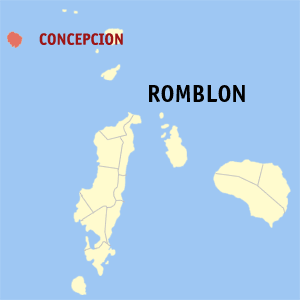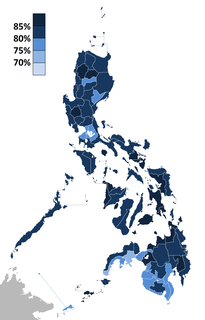A city is one of the units of local government in the Philippines. All Philippine cities are chartered cities, whose existence as corporate and administrative entities is governed by their own specific municipal charters in addition to the Local Government Code of 1991, which specifies their administrative structure and powers. As of December 12, 2015, there were 145 cities.

A municipality is a local government unit (LGU) in the Philippines. A municipality is also usually called town in its archaic term, since municipalities have the functions of a town since its inception. They are distinct from cities, which are a different category of local government unit. Provinces of the Philippines are divided into cities and municipalities, which in turn, are divided into barangays, formerly barrios. As of March 31, 2017, there are 1,489 municipalities across the country..

Taguig, officially the City of Taguig,, is a 1st class highly urbanized city in Metro Manila, Philippines. According to the 2015 census, it has a population of 804,915 people. The city is known for the Bonifacio Global City, one of the leading financial and lifestyle districts of the country, and Arca South, a planned unit development located at the site of the former Food Terminal Incorporated (FTI) in Western Bicutan. Taguig is also the home of SM Aura Premier, Market! Market!, the Department of Science and Technology, Manila American Cemetery, and the Heroes' Cemetery.

Philippine elections are of several types. The president, vice-president, and the senators are elected for a six-year term, while the members of the House of Representatives, governors, vice-governors, members of the Sangguniang Panlalawigan, mayors, vice-mayors, members of the Sangguniang Panlungsod/members of the Sangguniang Bayan, barangay officials, and the members of the Sangguniang Kabataan are elected to serve for a three-year term.

General Trias, officially the City of General Trias,, or simply known as General Trias City, is a 1st class city in the province of Cavite, Philippines. According to the 2015 census, it has a population of 314,303 people.

Concepcion, officially the Municipality of Concepcion, is a 6th class municipality in the province of Romblon, Philippines. According to the 2015 census, it has a population of 4,037 people.
The Philippines has four main classes of elected administrative divisions, often lumped together as local government units (LGUs). They are, from the highest to the lowest division:
- Administrative and autonomous regions
- Provinces and independent cities
- Municipalities and component cities
- Barangays

Mariano Trías y Closas is considered to be the first de facto Philippine Vice President of that revolutionary government established at the Tejeros Convention - an assembly of Philippine revolutionary leaders that elected officials of the revolutionary movement against the colonial government of Spain. When that assembly broke into factions, a truce known as the Pact of Biak-na-Bato was signed by the group and also recognized the elected officials and Trias as the vice president of Emilio Aguinaldo, who is also considered to be the first President of the Philippines. With the promulgation of the Malolos Constitution by the Malolos Convention, the First Philippine Republic was born. Under this Aguinaldo administration, Trias served in the cabinet initially as Secretary of Finance and, later, as Secretary of War.
The Sangguniang Panlalawigan, commonly known as the Provincial Board, is the Filipino language name given to the legislatures in Philippine provinces. They are the legislative branch of the province and their powers and responsibilities are defined by the Local Government Code of 1991. Along with the provincial governor, the executive branch of the province, they form the province's government.
The Sangguniáng Bayan is the local legislative branch of the municipal governments in the Philippines. It is responsible for passing ordinances and resolutions for the administration of a municipality. Its powers are defined by the Local Government Code, passed by the Congress in 1991.
A Barangay Kagawad, abbreviated as Kgwd., known in English as a Barangay Councilor and in Filipino as a konsehal ng barangay, is an elected government official who is a member of the Sangguniang Barangay, or Barangay Council, of a particular barangay. The barangay is the smallest political unit in the Philippines and the council serves as the legislature of the barangay and is headed by the barangay captain or Punong Barangay.

Officially local government in the Philippines, often called local government units or LGUs, are divided into three levels – provinces and independent cities; component cities and municipalities; and barangays. In one area, above provinces and independent cities, is an autonomous region, the Autonomous Region of Muslim Mindanao. Below barangays in some cities and municipalities are sitios and puroks. All of these, with the exception of sitios and puroks, elect their own executives and legislatures. Sitios and puroks are often led by elected barangay councilors.
Political dynasties are also known as Philippine political landscape. They are typically characterized as families that have established their political or economic dominance in a province and have coordinated efforts to move on to involvement in national government or other positions of national political prominence. Political dynasties usually have a strong, consolidated support base concentrated around the province in which they are dominant. Members of such dynasties usually do not limit their involvement to strictly political activities, and have been found participating in business or culture-related activities."
Local elections were held on the Philippines on May 13, 2013, the same day and on the same ballot as national elections. Elected were governors, mayors and council members of Philippine provinces, Philippine cities and Philippine municipalities. Separate elections for barangay officials were held on October.
The Zamboanga City Council is Zamboanga City's Sangguniang Panlungsod or local legislature.

A general election in the Philippines took place on May 9, 2016, for executive and legislative branches for all levels of government – national, provincial, and local, except for the barangay officials.

Local elections in the Philippines were held on May 9, 2016. This was conducted together with the 2016 general election for national positions. All elected positions above the barangay (village) level were disputed.
The 2019 Philippine general election will be conducted on May 13, 2019. It shall be a midterm election, where the winners will take office on June 30, 2019, midway the term of President Rodrigo Duterte.

















